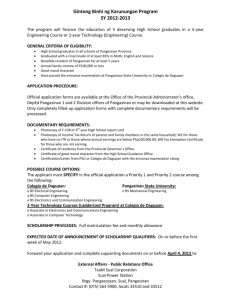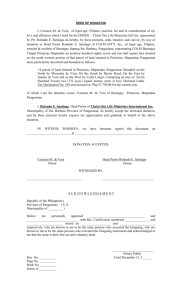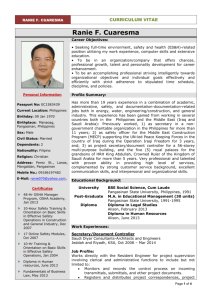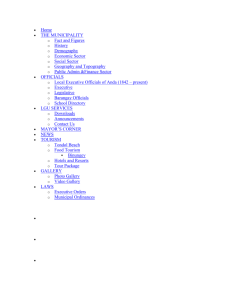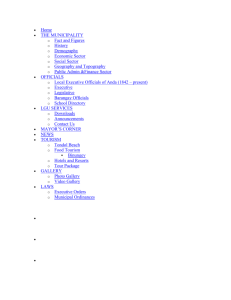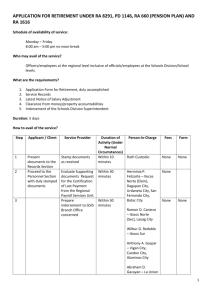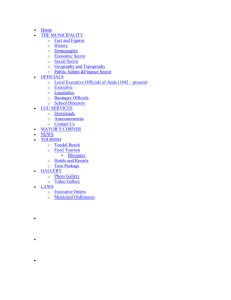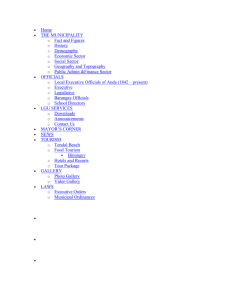terms of reference
advertisement
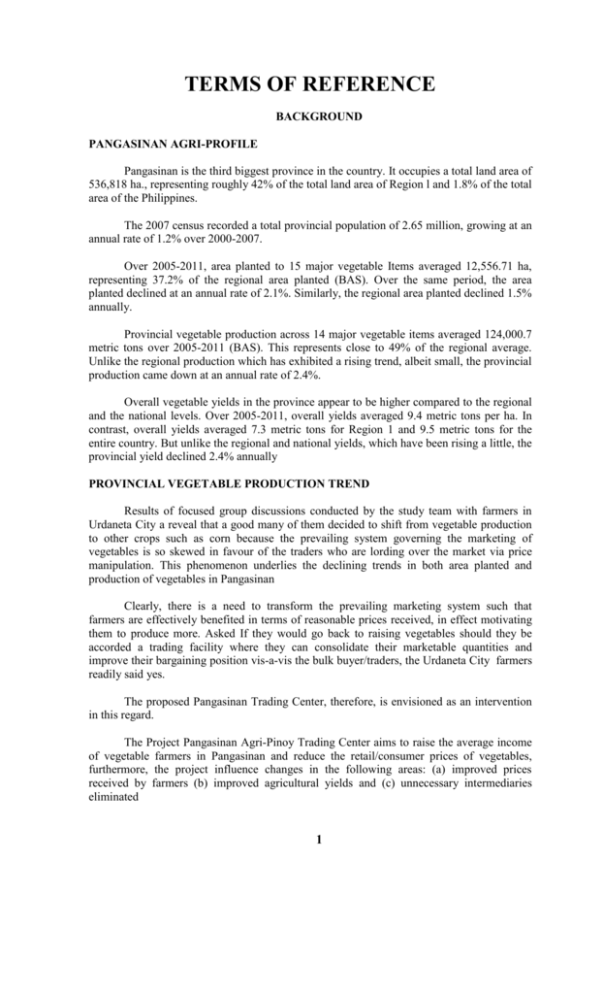
TERMS OF REFERENCE BACKGROUND PANGASINAN AGRI-PROFILE Pangasinan is the third biggest province in the country. It occupies a total land area of 536,818 ha., representing roughly 42% of the total land area of Region l and 1.8% of the total area of the Philippines. The 2007 census recorded a total provincial population of 2.65 million, growing at an annual rate of 1.2% over 2000-2007. Over 2005-2011, area planted to 15 major vegetable Items averaged 12,556.71 ha, representing 37.2% of the regional area planted (BAS). Over the same period, the area planted declined at an annual rate of 2.1%. Similarly, the regional area planted declined 1.5% annually. Provincial vegetable production across 14 major vegetable items averaged 124,000.7 metric tons over 2005-2011 (BAS). This represents close to 49% of the regional average. Unlike the regional production which has exhibited a rising trend, albeit small, the provincial production came down at an annual rate of 2.4%. Overall vegetable yields in the province appear to be higher compared to the regional and the national levels. Over 2005-2011, overall yields averaged 9.4 metric tons per ha. In contrast, overall yields averaged 7.3 metric tons for Region 1 and 9.5 metric tons for the entire country. But unlike the regional and national yields, which have been rising a little, the provincial yield declined 2.4% annually PROVINCIAL VEGETABLE PRODUCTION TREND Results of focused group discussions conducted by the study team with farmers in Urdaneta City a reveal that a good many of them decided to shift from vegetable production to other crops such as corn because the prevailing system governing the marketing of vegetables is so skewed in favour of the traders who are lording over the market via price manipulation. This phenomenon underlies the declining trends in both area planted and production of vegetables in Pangasinan Clearly, there is a need to transform the prevailing marketing system such that farmers are effectively benefited in terms of reasonable prices received, in effect motivating them to produce more. Asked If they would go back to raising vegetables should they be accorded a trading facility where they can consolidate their marketable quantities and improve their bargaining position vis-a-vis the bulk buyer/traders, the Urdaneta City farmers readily said yes. The proposed Pangasinan Trading Center, therefore, is envisioned as an intervention in this regard. The Project Pangasinan Agri-Pinoy Trading Center aims to raise the average income of vegetable farmers in Pangasinan and reduce the retail/consumer prices of vegetables, furthermore, the project influence changes in the following areas: (a) improved prices received by farmers (b) improved agricultural yields and (c) unnecessary intermediaries eliminated 1 Objectives of the Project Pangasinan Agri-Pinoy Trading Center 1. Increased household incomes for farmers and fisherfolk through improved prices received 2. Stable and reasonable wholesale prices paid by wholesalers, retailers/market vendors and food processors for quality agricultura1 and fishery products; and 3. Lower and stable prices of quality food crops, meat and fishery products paid by endconsumers. 4. Increased local employment opportunities; and 5. Developed technical and managerial capabilities of partner coops or associations of small farmers and fisherfolk, including other participating coops or association within the program area In view of a foregoing, the City Government of Urdaneta, Pangasinan decided to construct and put up an Pangasinan Agri-Pinoy Trading Center at Barangay Poblacion, Urdaneta City, Pangasinan particularly a Two(2) Storey Trading Center Building Due to urgency and time constraint to put up the proposed Pangasinan Agri-Pinoy Trading Center as per aforementioned reasons, it was decided that the Detailed Architectural and Engineering Designs of the building (based on the basic needs and design concepts of in-house planners) in coordination with the Department of Agriculture shall be included in the overall bidding process under the Revised Implementing Rules and Regulation of R.A. 9184 known as “ Government Procurement Reforms Acts” on the ground that City Government of Urdaneta does not have professional structural engineers, and other technical professional personnel who can prepare the detailed engineering design and related technical documents. It is within the foregoing perspectives that this TERMS OF REFERENCE (TOR) for the Construction of the Pangasinan Agri-Pinoy Trading Center under DESIGN AND BUILD SCHEME is being issued to eligible bidders Design and Build Projects. This refers to infrastructure projects where the City Government awards a single contract for the architectural/engineering design and construction to a single firm, partnership, corporation, joint venture or consortium in accordance with the Annex “G” of the Revised Implementing Rules and Regulations of R.A. 9184 known as “Government Procurement Reforms Acts” LEGAL BASIS 1. The City Government of Urdaneta, Pangasinan entered into a Memorandum of Agreement with the Department of Agriculture to establish Pangasinan AgriPinoy Trading Center with a financial support through fund transfer in the amount of TWENTY SIX MILLION NINE HUNDRED THOUSAND PESOS (Php 26,900,000.00) 2 2. A Competitive Public Bidding for the Construction of Pangasinan Agri-Pinoy Trading Center including the preparation of the entire Detailed Architectural and Engineering Designs (Design and Build Scheme) in accordance with RA 9184 as amended, otherwise known as “The Government Procurement Reform Act”, has been adopted considering the urgency of its implementation, economy in terms of time and expenses in bidding process, and as a way of overcoming the limited expert manpower services and technical resources of City Government. 3. The proposed Construction of the Pangasinan Agri-Pinoy Trading Center shall be financed by the Department of Agriculture in the amount of TWENTY SIX MILLION NINE HUNDRED THOUSAND PESOS (Php 26,900,000.00) for Phase 1 of the Project III. GENERAL SCOPE OF WORKS Performance Specifications and Parameters. The required performance specifications and criteria and its means of measurement based on the operating outputs and in accordance with appropriate design and construction standards, legal and technical obligations and any other relevant government commitments as required by existing laws and regulations. It shall not be drawn up to favor a particular solution, design and construction method. 1. The project covers the Entire Design of the Project and a Construction of the Pangasinan Agri-Pinoy Trading Center (Phase 1) under the DESIGN and BUILD SCHEME. 2. With respect to the construction of the buildings and other structures, the design and specifications shall conform to the standards set by: Department of Agriculture Department of Public Works and Highways (DPWH) National Building Code of the Philippines (NBCP) National Structural Code of the Philippines, 2001 Accessibility Law Fire Code of the Philippines Environmental Impact Statement as defined by the DENR other Engineering Standards. 3. Technical Reports on structural, mechanical, electrical, and sanitary engineering including actual test or site investigations shall be required. 4. A complete set of architectural, engineering drawings and structural plans in appropriate scales indicating all necessary details in order that the structures can be set out and constructed in accordance with guidelines and standards of the National Building Code of the Philippines shall be furnished by the bidder. 3 5. The bidder shall include in his proposal the cost of the proposed Trading Center Building, including the Detailed Architectural and Engineering Designs of said project and other related research, surveys, and technical studies and test or site investigation required, to come out with the design. 6. The Lowest Calculated Responsive Bidder shall enter into a contract with the City Government of Urdaneta, Pangasinan that shall be in the nature of a Design and Build Scheme of the project. 7. The winning bidder shall then proceed with the construction of the project under the terms and conditions set forth herein. 8. Upon Project Completion and Final Acceptance in accordance with the terms and conditions set forth herein, the Contractor shall turnover the completed project to the City Government for proper disposition. IV. DETAILED SCOPE OF WORKS A. PRE-PLANNING PHASE Preliminary Investigations. These shall include, among others, information on soil, geotechnical, hydrologic, hydraulic, seismic, traffic, and environmental conditions that shall be used to define project design criteria, to set the basis for any changed conditions and establish preliminary project cost estimates. The bidder, by submitting his bid, represents that: 1. He has thoroughly read/examined carefully understands fully all the bid documents and his bid will be in accordance therewith. 2. His bid is based upon the conditions and requirements of the bid documents without exception. 3. He has visited and inspected the Site of Works and its surroundings and satisfied himself as to all matters pertaining to the project, including the location and the nature of the work; climatic conditions; the nature and condition of the terrain: geological conditions at the site; transportation and communication facilities; the requirement and the availability of materials, labor, water, electric power and roads; the locations and extent of aggregate sources, and other factors that may affect the cost, duration and execution of the work; that he has determined the general characteristics of the project and the conditions indicated above. 4. He has acquainted and familiarized himself with all conditions, local or otherwise, affecting the carrying out of the contract work and has arrived at an estimate of the facilities available and the facilities needed for the project. 4 5. He is aware that City Government shall not assume any responsibility regarding erroneous interpretations out of any data furnished by the university. 6. He has familiarized himself with all laws, decrees, and regulations of the Philippines and City Government where the project is located which affect or apply to the operations and activities of the contractor. 7. He is aware that the construction period of the project shall be 240 calendar days reckoned seven(7) days from the date of the NOTICE TO PROCEED. B. PLANNING /ENGINEERING DESIGN PHASE 1. Surveys and Site Investigation a. Preliminary Survey and Mapping. These shall determine boundaries and provide stationing along control lines to establish feature and design criteria location, and identify existing and future right-of-way limits and construction easements associated with the City Government and Department of Agriculture’s conceptual design b. The bidder is expected to conduct actual site survey of the project area to identify preliminarily, metes and bounds of the proposed buildings. In the process, he shall be able to familiarize himself with site and nearby occupancy. It is also expected that the bidder shall familiarize himself with existing relevant materials and literature available in the City, to enable him to come up with an intelligent proposal. c. In the conduct of structural surveys, the following parameters need to be considered; (1) Man-made structures SUBMITTAL/S: Structure Map drawn on a paper size of 20” x 30” of convenient size and scale, in two(2) copies, one(1) copy white/blue print, and one(1) reproducible copy. 2. The bidder is also expected to conduct studies and research work as follows: i. Conduct Soil and Foundation Investigation Report required for planning and engineering design. If needed for the planning, analysis and design of the project the bidder is expected to conduct site investigation sufficient to determine the bearing capacity and other data of the soil foundation which is necessary for the overall structural analysis and design of the building, in order to ensure the safety of the structure. SUBMITTAL/S: Two (2) copies each of the Soil and Foundation Investigation Report ii. Determine existing and proposed infrastructure, facilities, utilities, etc., which may have bearing on the planning and design exercises; 5 iii.Utility Locations. The procuring entity shall provide information on existing utilities in and around the project’s area. The bidders shall identify/locate the existing utilities at the site, namely: (1) (2) (3) (4) Electrical Power Supply (underground and overhead) Water Supply Sewer and Storm Drainage Telephone Lines ( underground and overhead) SUBMITTAL/S: Two (2) copies each of existing utilities and the relocation plan shall be reflected in a utility map of paper size of 20”x 30”. The utility maps shall indicate which lines will be affected by the new construction and the extent that they will have to be relocated. iv. Environmental Impact Study Upon award, the bidder shall prepare an Environmental Impact Assessment (EIA) in order for the City to secure an Environmental Compliance Certificate (ECC) from the Environmental Management Bureau (EMB) of the Department of Environment and Natural Resources. 3. Proposed Site Development Plan 3.1. Maximize the output of the planning exercise to have a building footprint that has more useable areas within the design standards. Parking areas within the immediate vicinity of the building shall have to be considered as well as the smooth flow of vehicular traffic. Areas for appropriate landscaping adjacent to the structure shall be factored in. 3.2. If the structure will be positioned in accordance City Government and DPWH zoning requirements 3.3. The site development plan shall take into consideration but shall not be limited to the following planning parameters; (1) Adequate areas for support facilities such as bunkhouses for workers, temporary latrines, materials warehousing, equipment/motor pools, etc. shall be provided and shall be rationalized in terms of relative location and area. (2) Power supply requirements shall be supplied by the local power utility through the initiative of the contractor. (3) Water supply shall be supplied by the local water source. (4) The local telephone company shall supply communication facilities. SUBMITTAL/S; Site development plan in two (2) copies, one (1) copy white/blue print and one (1) reproducible copy drawn at a paper size of 24” x 36” in a convenient scale and all documents duly signed and sealed by a licensed Architect. 6 4. Proposed Construction of a Two(2) Storey Trading Center Building under Design and Build Scheme 1. Building Type The Two(2) Storey Building shall be constructed with a display area, toilet for male and female, ATM area, parking area, entrance and exit road ways, food stalls, dining hall, sleeping units/rooms and market division office. The lot area of construction shall have a minimum floor area of 3,832.50 square meters and will contain the following space utilization requirements; Section Minimum Required Area Remarks 292.50 sq.m 297.75 sq.m 301.44 sq.m 393.75 sq.m Phase 1 Phase 1 Phase 2 Phase 2 90.00 sq.m 90.00 sq.m 42.00 sq.m Phase 1 Phase 2 Phase 2 29 slots 29 slots Phase 1 Phase 2 436.33 sq.m. Phase 1 (except finishing) Phase 2 FACILITIES A. GROUND FLOOR 1. Display Area Section A Section B Section C Section D 2. Toilet for Male and Female Toilet AB Toilet CD 3. ATM Area 4. Parking Area AB CD 5. Entrance and Exit Road ways B. SECOND FLOOR 1. Dinning/Kitchen 2. Sleeping Units/Rooms 288.00 sq.m. 32 units@9 sq.m. 3. Toilets (Male and Female) Right Side Left Side 4. Market Division Office 12.00 sq.m. 12.00 sq.m. 90.00 sq.m. Phase 2 Phase 2 Phase 2 SUBMITTAL/S: Floor Plans at a suitable scale, Two (2) sections, Four Elevations, in two(2) copies- one(1) copy white/blue print, and one(1) reproducible copy, drawn at a paper size of 20” x 30” in a convenient scale, all documents duly signed & sealed by a licensed Architect. 7 2. Architectural Design (1) The architecture must be modern and promote urban renewal in the Business District. (2) The building should be designed for natural ventilation system (3) The roof must be insulated (4) The bidder shall prepare the Architectural, Electrical, Sanitary and Mechanical Plans and in accordance with the requirements of the National Building Code of the Philippines. 5. Minimum Finishes 5.1 All interior floor areas shall be plain cement flooring. 5.2 All stairway steps shall be provided with anti-slip nosing , either tiles with built-in anti- slip features, aluminum or brass metal nosing which ever is best applicable. 5.3. All concrete-finished walls shall be plain painted with appropriate colors based on the preference of the owner. 5.4 Generally the ceiling shall be metal furring with Fisem. 5.5 Windows shall be aluminum framed glass and steel casement combination where ever is best situated. 5.6 External façade finishes shall reflect modern structures. SUBMITTAL/S: One colored perspective and (1) one black and white print, drawn at a paper size of 11” x 17” in a convenient scale. 6. Structural Design (1) The bidders shall prepare the necessary structural analysis/ calculation and design of the structural members (foundations, columns, girders, beams shear walls) in accordance with the National Building Code of the Philippines with its referral codes such as the National Structural Code of the Philippines, etc. The Design for the structure shall take into account, among other things, seismic requirements of the area to determine the optimum safety of the whole structure and to minimize possible earthquake damage. The design must consider the occurrence of flooding in the site and the typhoon strength for the Ilocos Region. (2) On the basis of the Data obtained from the detailed site investigations, topographical/ engineering, foundation investigation, material testing, survey of existing site conditions, the seismic requirements of the area and other investigations required to obtain the data necessary to ensure the safety of the structure. SUBMITTAL/S: Two(2) copies of the structural analysis/calculations and design signed by a structural engineer. 8 7. Engineering Drawings (1) General i. The detailed design shall conform to the general standards adopted by the National Building Code and other pertinent laws of building construction. ii. All design assumptions shall be based on the results of the required technical studies, detailed analysis, and design computations. iii. The technical drawings and specifications shall clearly indicate all the details required to ascertain the care and thoroughness devoted in the preparation of the drawings. (2) Drainage and Sewerage i. Drainage and sewerage shall be open-type with steel gratings. ii. The drainage layout shall show all the required information such as direction of flow, manhole to manhole distance and sizes of lines, invert elevation of manholes/canals, location of outfalls, etc. iii. Design shall be supported with design computation. SUBMITTAL/S: Drainage layout plan drawn at a paper size of 20” x 30” with suitable scale and details, in two (2) copies, one(1) reproducible and one(1) white/blue print and two (2) copies of design computations, duly signed and sealed by a Sanitary Engineer. (3) Water Supply and Distribution System i. The bidders shall carry out a detailed design for the water supply, drainage and sewer system of the building(s). The design should be on the basis of the results of the hydrological study and, the drainage survey taking into consideration the general and particular problems such as the source and the volume of water supply, water consumption, piping network, drainage discharge area, and conveyance and treatment of sewer flow, in accordance with the applicable laws, rules and regulations governing health safety and sanitation. ii. Water supply source will be sourced from the local water source. iii. Water outlets should be provided on convenient locations for the cleaning/flushing. SUBMITTAL/S: Water Supply Plan drawn on a paper size of 20” x 30” with details on any convenient scale, in two(2) copies, one(1) reproducible and one(1) white/blue print all document duly signed and sealed by a Sanitary Engineer. 9 (4) Electrical Engineering Drawings i. The bidders shall prepare a design for the electrical and power supply system of the building in accordance with the Fire Code of the Philippines and the National Building Code of the Philippines. ii. The bidder shall prepare a design for the electrical and power supply system considering ease of maintenance and prevention of illegal connection. iii. Electrical supply will be sourced from the local electrical utility iv. Provision of individual metering for each section v. Provision for general lighting and one meter SUBMITTAL/S: Electrical Layout Plan showing system of wiring, source, distribution, riser diagrams, panel boxes and switches, and all other pertinent materials required. Two sets of plans drawn on a paper size of 20“x 30” with details on any convenient scale, one (1) reproducible copy and one(1) white/blue print together with electrical design analysis duly signed and sealed by a Professional Electrical Engineer. OTHER SUBMITTAL/S : Two(2) copies of Technical Specifications in all work items involved (structural, plumbing, electrical and others) (5) Ancillary Works The bidders shall provide the ancillary works such as street, parking, and property boundary lights, pavement markings, traffic signs landscaping, etc. C. PROJECT COST ESTIMATES INCLUDES THE QUANTITIES AND COST CALCULATIONS The bidders shall submit the quantities and cost of the different types of works to be carried out in accordance with DPWH Department Order No. 72 series of 2012 dated October 5, 2012. In particular, the quantities and cost of each work item shall be calculated and a bill of quantities shall be prepared. The bidders shall draw up a unit price analysis for each of the main pay work items. The unit price of each of the main work pay items shall include: The unit price of each of the main work pay items shall include: I. Cost of the Preliminary and Detailed Architectural and Engineering Design – at least 3% of the Project Cost in accordance NEDA guidelines 10 II. Construction Cost of the Project; A. The Direct Cost are the following: A.1. Cost of Materials to be used in doing the work item called for, which shall include the following: A.1.1 Cost of source, including processing, crushing, stockpiling, loading, royalties, local taxes, construction and/or maintenance of haul roads, etc. A.1.2 Expenses for hauling to project site. A.1.3 Handling expenses A.1.4 Storage A.1.5 Allowance for waste and/or losses, not to exceed 5% of materials requirement.. A.2. Cost of Labor: A.2.1 Salaries and wages as authorized by the Department of Labor and Employment A.2.2 Fringe benefits, such as vacation and sick leaves, benefits under the workmen’s Compensation Act GSIS and SSS contribution, allowances, 13 month pay, bonuses etc. A.3 Equipment Expenses: A.3.1 Rental of equipment which shall be based on the prevailing "Associated Construction Equipment Lessors, Inc." (ACEL) rental rates approved for use by the DPWH (Presently it is the 2009 ACEL Rates). Rental rates of equipment not indicated in the ACEL booklet shall be taken from the rental rates prepared by the DPWH Bureau of Equipment. For simplicity incomputation, the operated rental rates are preferred over the bare rental rates as the former includes operator's wages, fringe benefits, fuel, oil, lubricants and equipment maintenance. The make, model and capacity of the equipment should be indicated in the detailed unit cost analysis. . A.3.2 Mobilization and demobilization, shall be treated as a separate pay item. It shall be computed based on the equipment requirements of the project stipulated in the proposal and contract booklet. In no case shall mobilization and demobilization exceed 1% of the Estimated Direct Cost (EDC) of the civil works items. 11 B. The Indirect Cost shall consist of the following: B.1 Overhead Expenses - ranges from 5 – 8 % of the EDC, which includes the following: B.1.1 Engineering and Administrative Supervision. B.1.2 Transportation allowances. B.1.3 Office Expenses, e.g., for office equipment and supplies, power and water consumption, communication and maintenance. B.1.4 Premium on Contractor's All Risk Insurance (CARl). B.1.5 Financing Cost. a. Premium on Bid Security b. Premium on Performance Security (c) Premium on Surety for Advance Payment (d) Premium on Warranty Bond (one year) B.2 Contingencies - ranges from 0.5 - 3% of the EDC. These include expenses for meetings, coordination with other stakeholders, billboards, stages during ground breaking & inauguration ceremonies and other unforeseen events B.3 Miscellaneous Expenses - ranges from 0.5 - 1% of the EDC. These include laboratory tests for quality control and plan preparation. B.4 Contractor’s Profit Margin – shall be 8% of EDC for projects above Php 5 million and 10% for projects Php 5 million and below B.5 VAT Component - shall be 12% of the sum of the EDC, OCM and Profit. B.6 The following items shall not be subjected to OCM and Profit markup: B.6.1 Mobiiization and demobiiization B.6.2 Provision of Service Vehicle B.7 The following non-civil works items shall not be subjected to OCM mark-up: B.7.1 Field/Laboratory Office & Living Quarters (Rental Basis) B.7.2 Furnishing of Furnitures, Laboratory Equipment, Survey Equipment and Consumables B.7.3 Assistance to the Engineers B. 7.4 Photographs B.7.5 Heaith and Safety B.7.6 Traffic Management B.7.7 Environmental Compliance B.7.8 Communication Equipment, etc. 12 NOTE: For the percentage to be used for Nos. 8.1, 8.2 and 8.3, see OCM (Overhead, Contingencies and Miscellaneous) column in the tabulation below . INDIRECT COST % FOR OCM AND PROFIT ESTIMATED DIRECT COST (EDC) OCM (% OF EDC) (% OF EDC) 12 9 7 6 10 8 8 8 Up to P5 Million Above P5M up to P50M Above P50M up to P150M Above P150M TOTAL INDIRECT COST % FOR OCM AND PROFIT PROFIT 22 17 15 14 D. CONTRACT DOCUMENTATION PHASE The Contract documentation phase shall be governed by the R.A. 9184 “Government Procurement Reforms Act and its Revised Implementing Rules and Regulations and Provisions in the Bid Documents E. CONSTRUCTION PHASE 1. Permits and Clearances The bidders shall defray and all expenses necessary and incidental for the University to be able to secure the Environmental Clearance Certificate (ECC), including the corresponding Tree Cutting Permit (if any tree needs to be cut from the concerned government agencies, if necessary). The contractor shall, upon authorization of the City, make representations with the government agencies concerned to expedite the release of the same. Obtain and pay the corresponding fees for all necessary approvals, permits and certificates such as the following: a. b. c. d. Building Permit Certificate of Completion of the Building Occupancy Permit All other permits as may be required for the construction 13 2. Temporary Structures & Facilities The contractor shall provide and maintain the following: a. Temporary office and/or quarters for the contractor’s project team personnel with water, light, telephone and toilet facilities. b. Temporary bunkhouse/quarters for the contractor’s workforce complete with toilet and bath facilities. 3. Mobilization The contractor shall mobilize all the required project team personnel, equipment, tools and manpower with the required skills and insufficient number as may be necessary for his efficient undertaking of the project. 4. Construction Proper The contractor shall prosecute all the works under the contract in strict accord with standard engineering methodology and procedures and shall be responsible for maintaining cleanliness and orderliness in the project area throughout the duration of the contract. 5. Electrification The contractor shall pay to the local power utility the cost of providing the additional electrical distribution facilities for the project. 6. Material Testing All material testing shall be conducted by the accredited testing laboratories. 7. As-built plans The contractor shall cause the preparation and submission of as-built plans duly signed and sealed by all concerned parties involved in the construction in the same sheet size and scale as the original drawings in one (1) white print copy and one (1) reproducible copy. I. BIDDING MECHANICS AND IMPLEMENTATION PHASE: Bidding Mechanics and the Implementation Phase shall be govern by the R.A. 9184 the “Government Procurement Reforms Acts” and its Revised Implementing Rules and Regulations as well as Bid Documents. 14
